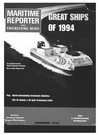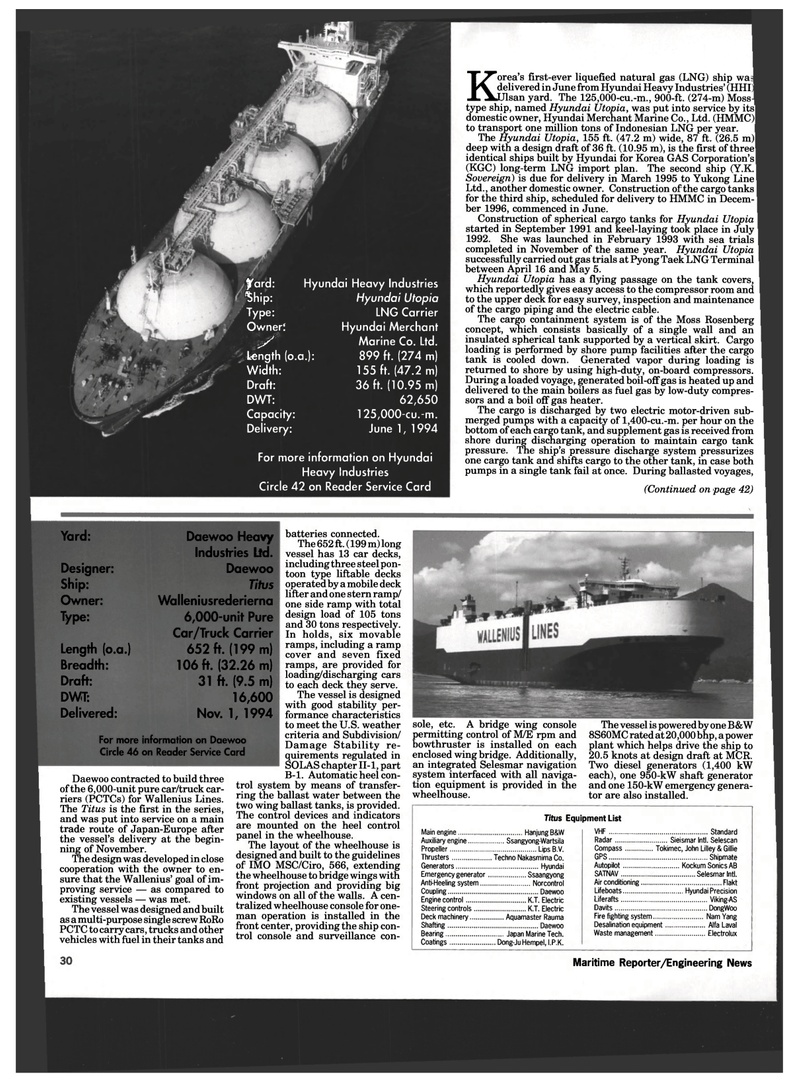
Page 28: of Maritime Reporter Magazine (December 1994)
Read this page in Pdf, Flash or Html5 edition of December 1994 Maritime Reporter Magazine
Yard: Hyundai Heavy Industries
Ship: Hyundai Utopia
Type: LNG Carrier
Owner? Hyundai Merchant y
Marine Co. Ltd. length (o.a.): 899 ft. (274 m)
Width: 155 ft. (47.2 m)
Draft: 36 ft. (10.95 m)
DWT: 62,650
Capacity: 125,000-cu.-m.
Delivery: June 1, 1994
For more information on Hyundai
Heavy Industries
Circle 42 on Reader Service Card
Titus Equipment List
Main engine
Auxiliary engine
Propeller
Thrusters
Generators
Emergency generator .
Anti-Heeling system
Coupling.
Engine control.
Steering controls .
Deck machinery.
Shafting .
Bearing...
Coatings .
Hanjung B&W
Ssangyong-Wartsila
LipsB.V.
Techno Nakasmima Co.
Hyundai
Ssaangyong
Norcontrol
Daewoo
K.T. Electric
K.T. Electric
Aquamaster Rauma
Daewoo .... Japan Marine Tech.
Dong-Ju Hempel, I.P.K.
VHF Standard
Radar Sieismar Intl. Selescan
Compass Tokimec, John Lilley & Gillie
GPS Shipmat
Autopilot Kockum Sonics AB
SATNAV Selesmar Intl.
Air conditioning Flakt
Lifeboats Hyundai Precision
Liferafts Viking-AS
Davits DongWoo
Fire fighting system Nam Yang
Desalination equipment Alfa Laval
Waste management Electrolux
Korea's first-ever liquefied natural gas (LNG) ship wa delivered in June from Hyundai Heavy Industries' (HHI IJlsan yard. The 125.000-cu.-m., 900-ft. (274-m) Moss type ship, named Hyundai Utopia, was put into service by its domestic owner, Hyundai Merchant Marine Co., Ltd. (HMMC) to transport one million tons of Indonesian LNG per year.
The Hyundai Utopia, 155 ft. (47.2 m) wide, 87 ft. (26.5 m) deep with a design draft of 36 ft. (10.95 m), is the first of three identical ships built by Hyundai for Korea GAS Corporation's (KGC) long-term LNG import plan. The second ship (Y.K.
Sovereign) is due for delivery in March 1995 to Yukong Line
Ltd., another domestic owner. Construction of the cargo tanks for the third ship, scheduled for delivery to HMMC in Decem- ber 1996, commenced in June.
Construction of spherical cargo tanks for Hyundai Utopia started in September 1991 and keel-laying took place in July 1992. She was launched in February 1993 with sea trials completed in November of the same year. Hyundai Utopia successfully carried out gas trials at Pyong Taek LNG Terminal between April 16 and May 5.
Hyundai Utopia has a flying passage on the tank covers, which reportedly gives easy access to the compressor room and to the upper deck for easy survey, inspection and maintenance of the cargo piping and the electric cable.
The cargo containment system is of the Moss Rosenberg concept, which consists basically of a single wall and an insulated spherical tank supported by a vertical skirt. Cargo loading is performed by shore pump facilities after the cargo tank is cooled down. Generated vapor during loading is returned to shore by using high-duty, on-board compressors.
During a loaded voyage, generated boil-off gas is heated up and delivered to the main boilers as fuel gas by low-duty compres- sors and a boil off gas heater.
The cargo is discharged by two electric motor-driven sub- merged pumps with a capacity of l,400-cu.-m. per hour on the bottom of each cargo tank, and supplement gas is received from shore during discharging operation to maintain cargo tank pressure. The ship's pressure discharge system pressurizes one cargo tank and shifts cargo to the other tank, in case both pumps in a single tank fail at once. During ballasted voyages, (Continued on page 42)
Yard: Daewoo Heavy
Industries Ltd.
Designer: Daewoo
Ship: Titus
Owner: Walleniusrederierna
Type: 6,000-unit Pure
Car/Truck Carrier
Length (o.a.) 652 ft. (199 m)
Breadth: 106 ft. (32.26 m)
Draft: 31 ft. (9.5 m)
DWT: 16,600
Delivered: Nov. 1, 1994
For more information on Daewoo
Circle 46 on Reader Service Card
Daewoo contracted to build three of the 6,000-unit pure car/truck car- riers (PCTCs) for Wallenius Lines.
The Titus is the first in the series, and was put into service on a main trade route of Japan-Europe after the vessel's delivery at the begin- ning of November.
The design was developed in close cooperation with the owner to en- sure that the Wallenius' goal of im- proving service — as compared to existing vessels — was met.
The vessel was designed and built as a multi-purpose single screw RoRo
PCTC to carry cars, trucks and other vehicles with fuel in their tanks and batteries connected.
The 652 ft. (199 m) long vessel has 13 car decks, including three steel pon- toon type liftable decks operated by a mobile deck lifter and one stern ramp/ one side ramp with total design load of 105 tons and 30 tons respectively.
In holds, six movable ramps, including a ramp cover and seven fixed ramps, are provided for loading/discharging cars to each deck they serve.
The vessel is designed with good stability per- formance characteristics to meet the U.S. weather criteria and Subdivision/
Damage Stability re- quirements regulated in
SOLAS chapter II-1, part
B-l. Automatic heel con- trol system by means of transfer- ring the ballast water between the two wing ballast tanks, is provided.
The control devices and indicators are mounted on the heel control panel in the wheelhouse.
The layout of the wheelhouse is designed and built to the guidelines of IMO MSC/Ciro, 566, extending the wheelhouse to bridge wings with front projection and providing big windows on all of the walls. A cen- tralized wheelhouse console for one- man operation is installed in the front center, providing the ship con- trol console and surveillance con- sole, etc. A bridge wing console permitting control of M/E rpm and bowthruster is installed on each enclosed wing bridge. Additionally, an integrated Selesmar navigation system interfaced with all naviga- tion equipment is provided in the wheelhouse.
The vessel is powered by one B&W 8S60MC rated at 20,000 bhp, a power plant which helps drive the ship to 20.5 knots at design draft at MCR.
Two diesel generators (1,400 kW each), one 950-kW shaft generator and one 150-kW emergency genera- tor are also installed. 26D
Maritime Reporter/Engineering News

 27
27

 29
29
